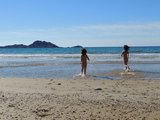What I learned from my first Place Management and Marketing Symposium

A couple of weeks ago, from 14 till 17 April 2014, we of Green Corfu together with Dr Heather Skinner organised the 1st Corfu Symposium on Managing and Marketing Places. It was held at Hotel Fiori near Corfu town and the delegates were both academics and practicioners of the tourism sector. This was the second time we organised an event on tourism (see www.alternativekerkyra.gr for the first one) but it was the first time academics and researchers in the field of place management and marketing were invited. It was quite an experience, there were many good discussions, many connections were made and of course we all had a good time. After all, Symposium is a Greek word composed of Syn, meaning together and Posi, meaning drinking! And we did drink top quality, local Corfiot beers and wines…
- Dr Heather Skinner opening the Symposium
- 1st day attendants
- All delegates
- Listening to Corfu Beer’s Spyros Kaloudis
- Zoe Nowak on gastro tourism. Possibly the most impressive presentation
- Enjoying Theotoky wine!
- Alex on Arillas
- Corfu beer straight from the tank
- Yummy!
- Delegates on Arillas beach
- Heather, Pepe and Alex, the Symposium team
- Round table where conclusions where drawn and future plans were made
- Toasting to a good Symposium
- Final dinner at the Venetian Well
So, after this exciting and eventful four days, I will try to share with you the most important things that stuck with me:
- All decisions a person takes are processed by the part of the brain handling emotions, called the ‘amygdala’. So all our decisions are emotional!
- People don’t travel somewhere because it is a certain way. They go because they perceive it to be a certain way. Perception is key.
- Place is a better word to refer to a town/area/island than destination because it includes many more meanings. People live, work and function in a place. Destination just refers to a place where people go, usually to spend money.
- A place’s image consists of the ‘induced‘ image, which is what the place itself tries to project through all kinds of advertising, and the ‘organic‘ image, which is what is projected buy other sources such as visitor reviews, films, documentaries etc. You can control the induced image, but not so easily the organic image.
- We can enhance the perception, or image people have of Corfu if we use correctly the different “narratives” we have of the place. These narratives include books, paintings, films, photographs, and stories we can get out of people.
- There are two general trends in tourism, opposite to each other. On one hand there is the expansion for all-inclusive holidays and on the other the demand for more personalised, experience-based holidays. Corfu can benefit from catering for the needs of the second group of guests, utilising its landscape and biodiversity, local products, friendliness of the people and alternative forms of tourism.
- Food and drink are very important in a visitor’s experience. Taste and smell are the senses with the strongest connection to memories and emotions. So, promoting local products to tourists has a lasting effect and influences their decisions (see point 1!).
- Reality TV is always bad for the image of a place. In the case of Corfu, the brand of Kavos is threatening to cannibalise the brand of Corfu (“Ooh, if those things are happening in Kavos, there’s no way I am going to Corfu!”).
- A lot of research has been done on projects to revive neglected city centres. This relates a lot to what we are trying to do in Arillas. The results show that the only successful initiatives were grassroots or bottom-up. The government (local, regional or national) is more often a problem than a help.
- Getting academics and practicioners together in a Symposium can result in great conversations, lots of fun and very concrete connections and results.
I am sure that the 2nd Corfu Symposium on Managing and Marketing Places will be very interesting and, more importantly for me, there will be specific research results on Corfu. This scientific research can serve as the basis to designing and implementing a tourism strategy that will benefit all stakeholders and not just the big tour operators.
You can read more on next year’s Symposium on www.corfusymposium.com. We would love to have your feedback and hope to see many of you participate next year!














 Green Corfu - Alternative holidays, meditation, walking, cycling, organic, healing, Mother Nature, local products, accommodation and more
Green Corfu - Alternative holidays, meditation, walking, cycling, organic, healing, Mother Nature, local products, accommodation and more